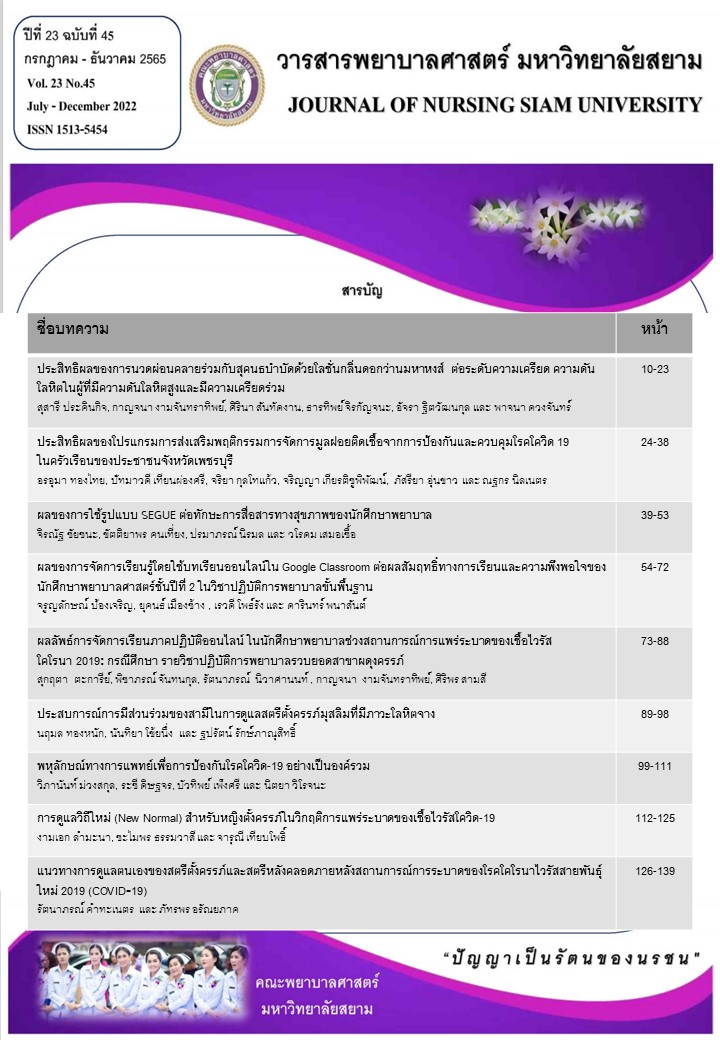Effectiveness of Relaxation Massage Incorporated Aromatherapy with Butterfly Lilly Lotion on Stress Level, Blood Pressure Among Persons with High Blood Pressure and Stress
Keywords:
Relaxation massage, aromatherapy, butterfly lilly, stress, blood pressureAbstract
Objective: To determine the effectiveness of relaxation massage incorporated aromatherapy with butterfly lilly lotion on stress levels, blood pressure in people with high blood pressure and stress
Method: The research was quasi-experimental research under the Three Group Pretest –Posttest Design model. It was conducted in 2 phases, the first phase was to study the development of relaxation massage postures and aromatherapy with butterfly lilly lotion and the second phase was to study the effectiveness of relaxation massage combined with aromatherapy with butterfly lilly lotion on stress levels and blood pressure among persons with high blood pressure and stress. The data was analyzed compare the mean scores before and after within the sample (Pair T Test). One-way ANOVA was used to compare between groups.
Results: The research findings were as follows : 1) The subjects who used butterfly lilly lotion only had significant decreased blood pressure and stress significantly (p<0.05) 2) The subjects who used relaxation massage incorporated aromatherapy with butterfly lilly lotion had significant decreased blood pressure and stress significantly (p<0.05) 3) The subjects who used relaxation massage incorporated aromatherapy with butterfly lilly lotion had decreased blood pressure and stress were more than who used butterfly lilly lotion only significantly (p<0.05)
Conclusion: The relaxation massage incorporated aromatherapy with butterfly lilly lotion could relief stress and decreased blood pressure were more than aromatherapy with butterfly lilly lotion only.
References
กองโรคไม่ติดต่อ กรมควบคุมโรค กระทรวงสาธารณสุข. (2564). รายงานประจำปี 2564. กรุงเทพฯ: สำนักพิมพ์อักษรกราฟฟิคแอนด์ดีไซน.
ขวัญเรียม นิมสุวรรณ์, สุชาดา กรเพชรปาณี, ศราวิน เทพสถิตย์ภรณ์. (2562). การพัฒนาโปรแกรมนวดผสมผสานการนวดไทยแบบราชสำนักกับการกดจุดแบบจีนสำหรับผ่อนคลายความเครียดและเพิ่มคุณภาพการนอนหลับในผู้ที่มีอาการนอนไม่หลับชนิดปฐมภูมิ. วิทยาการวิจัยและวิทยาการปัญญา, 16(2):176-188.
จิรัชฌา อุดมชัยสกุล. (2555). คู่มือร้านยา เล่ม 1: ความรู้เรื่องยาเบื้องต้นและแนวทางการซักถามอาการเพื่อให้การรักษาเบื้องต้น(พิมพ์ครั้งที่ 2). กรุงเทพฯ:ศิษฎิกร.
ดุษฎี อุดมอิทธิพงศ์, กฤตนัย แก้วยศ และเกยูรมาศ อยู่ถิ่น.(2561). น้ำมันหอมระเหยกับการทำงานของระบบประสาทและความรู้สึกทางอารมณ์. วารสารสถาบันจิตเวชศาสตร์สมเด็จเจ้าพระยา, 12(2): 48-62.
ชมพูนุช สุภาพวานิช, ชุติกาญน์ นิโกบ, และ คอลีเยาะอะแซ. (2561). ผลของการใช้สุคนธบำบัดกลิ่นกระดังงาร่วมกับการนวดเท้าต่อคุณภาพการนอนหลับของ ผู้สูงอายุในศูนย์พัฒนาการจัดสวัสดิการสังคมผู้สูงอายุบ้านทักษิณ จังหวัดยะลา. วารสารสาธารณสุขและวิทยาศาสตร์สุขภาพ, 1(1): 34-46.
นันท์ชนก เปียแก้ว, วิภาวดี ลี้มิ่งสวัสดิ์ และ ถนอมวงศ์ กฤษณ์เพ็ชร. (2558). ผลของการสูดดมน้ำมันลาเวนเดอร์ที่มีต่อการลดความเครียด และคลื่นสมองของหญิงวัยรุ่น. วารสารวิทยาศาสตร์การกีฬาและสุขภาพ, 16(2): 63-72.
ปริยาภัทร สิงห์ทอง, วาริณี แสงประไพ, วิมลรัตน์ ผ้าผิวดี และพีรนัย ศรีวงศ์. (2561). ผลทันทีของการนวดพื้นฐานแบบราชสำนักร่วมกับการประคองสมุนไพรต่ออัตราการแปรปรวนของการเต้นของหัวใจในอาสาสมัครที่มีภาวะเครียด. วารสารหมอยาไทยวิจัย, 4(2): 27-38.
สุวัฒน์ มหัตนิรันดร์กุล, วนิดา พุ่มไพศาลชัย และพิมพ์มาศ ตาปัญญา. (2540). การสร้างแบบวัดความเครียดสวนปรุง. วารสารสวนปรุง, 13(3): 1-20.
สุธัญญา พรหมสมบูรณ์, อนงค์นาฏ โสภณางกูร, ประพฤติ พรหมสมบูรณ และ สุชาดา กรเพชรปาณ. (2560). ประสิทธิภาพของน้ำมันหอมระเหยจากพืชสมุนไพร 5 ชนิด ต่อการผ่อนคลายความเครียด. วารสารวิจัย, 10(2): 68-75.
อุทัย โสธนะพันธุ์. (2560). กลไกการออกฤทธิ์ของสุคนธบําบัดต่อระบบประสาทส่วนกลาง. บทความฟื้นฟูวิชาการออนไลน์สำหรับศึกษาต่อเนื่องทางเภสัชศาสตร์. ภาควิชาเภสัชเวท. คณะเภสัชศาสตร์. มหาวิทยาลัยศิลปากร.
อําพล บุญเพียร, วรินทร เชิดชูธีรกุล และวินัย สยอวรรณ. (2562). การศึกษาผลของการสูดดมกลิ่นน้ำมันดอกว่านมหาหงส์ ต่อระบบประสาทอัตโนมัติและอารมณ์ความรู้สึก. วารสารการพยาบาล การสาธารณสุขและการศึกษา, 20(2): 147-154.
Cohen, L. and Holliday, M. (1982). Statistics for Social Sciences. Harper & Row, London.
Conversano, C., Orrù, G., Pozza, A., Miccoli, M., Ciacchini, R, Marchi, L, & Gemignani, A., (2021). Is Mindfulness-Based Stress Reduction Effective for People with Hypertension? A Systematic Review and Meta-Analysis of 30 Years of Evidence. Int. J. Environ. Res. Public Health, 18(2882): 1-20.
Fung, H , Lau, B, Ngai, S C and Tsang, H. (2021). Therapeutic Effect and Mechanisms of Essential Oils in Mood Disorders: Interaction between the Nervous and Respiratory Systems. Int. J. Mol. Sc, 22(4844): 1-17.
Gyeltshen, D., Deenan, A., Wacharasin, C. (2022). Psychological Stress among Patients with Hypertension in Bhutan. The Journal of Faculty of Nursing Burapha University, 28(4): 63-74.
Katz, J. and Rosenbloom, B. (2015). The golden anniversary of Melzack and Wall’s gate control theory of pain: Celebrating 50 years of pain research and management. Pain Res Manag, 20(6): 285–286.
World Health Organization (WHO). (2019). More than 700 million people with untreated Hypertension: Retrived 16 th,September, 2022 from https://www.who.int/news/item/25-08-2021-more-than-700-million-people-with-untreated-hypertension.
Downloads
Published
How to Cite
Issue
Section
License
Copyright (c) 2022 Journal of Nursing, Siam University

This work is licensed under a Creative Commons Attribution-NonCommercial-NoDerivatives 4.0 International License.
Content and information published in the Journal of Nursing, Siam University is the comment and responsibility of the authors.
Articles, information, images, etc. published in the Journal of Nursing. Siam University is the copyright of the Journal of Nursing, Siam University. If any person or entity wants to take all or part of it for publication for any purposes, please reference the Journal of Nursing, Siam University.



